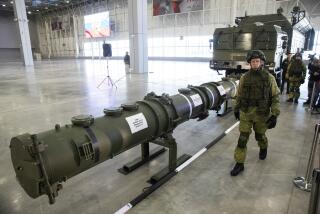Reagan to Decide Whether to Uphold SALT II : Continued Observance of Arms Treaty May Focus on Two Old Submarines
WASHINGTON — As another new Trident missile submarine prepares for sea trials, President Reagan heard arguments Tuesday on whether to continue observing the second U.S.-Soviet strategic arms agreement.
To stay within the terms of the treaty, which was never ratified by the United States but has been observed by both the Carter and Reagan administrations, the President must order the dismantling of two old missile-firing submarines. Some highly placed presidential aides have urged him to ignore the treaty’s limits, in retaliation for alleged Soviet violations.
The Nevada, the new submarine nearing sea trials, carries 24 multiple-warhead missiles, enough to take the United States’ weapons over the limit of 1,200 set by the arms treaty, widely known as SALT II.
Reagan’s Options
No decision was made at the meeting of the National Security Planning Group, several officials said. Because the new submarine will not go to sea until May, the President has several weeks to consider the options reportedly put to him:
--To drydock rather than dismantle the two old subs for as long as a year and to convert more B-52 bombers so that they can carry cruise missiles. If this course, advocated by the Defense Department, does not succeed in pressuring the Soviets to stop their own SALT II violations, the United States would make these weapons operational, thereby violating the agreement.
--To continue the current policy of observance but, in retaliation for Soviet violations of existing arms pacts, to increase spending on decoys and other measures that would improve the effectiveness of U.S. missiles. Under this approach, advocated by the State Department and to some degree by the Joint Chiefs of Staff, the United States would continue to stay within the limits of the SALT II treaty.
--To renounce SALT II because--besides being unratified by the Senate--the treaty was to expire on Dec. 31, 1985.
The treaty, signed by former President Jimmy Carter in 1979, was submitted to the Senate for ratification but withdrawn after the Soviet invasion of Afghanistan later that year.
Assailed, Observed Anyway
Although the Reagan Administration called the agreement “fatally flawed,” it announced in 1981 that it would “not undercut” its provisions as long as the Soviets showed equal restraint.
The United States could stay below the missile limit by dismantling two old 16-missile subs. Drydocking the old subs also remains a possible way to stay within the treaty, although some U.S. officials believe that keeping them on the docks would represent a clear violation.
The current debate is a rerun of last June’s, when another new Trident submarine, the Ohio, with 24 multiple-warhead missiles, would have taken the U.S. total for such weapons above 1,200. With last November’s summit meeting between Reagan and Soviet leader Mikhail S. Gorbachev only a few months away, the President chose to dismantle one old submarine rather than violate the treaty.
In making that decision, he said he was “going the extra mile” in hopes that the Soviets would stop or correct their alleged violations of SALT II and other arms control agreements. He appeared to condition his decision in future cases of this kind by that and two other standards: whether the Soviets slowed their military buildup and whether progress was made at U.S.-Soviet arms control talks.
Scant Geneva Progress
At the summit, however, Reagan and Gorbachev promised to accelerate the Geneva talks. Little progress has been made there, however.
Similarly, although some intelligence figures show that the pace of Soviet military production is slowing, the latest Pentagon study of Soviet military power claims there has been no letup in the Kremlin’s military program.
Defense Department officials insist that the Administration, after repeatedly charging the Soviet Union with violating arms pacts, must ultimately take retaliatory action.
Any violation, according to arms control champions, would invite the Soviets to break out existing ceilings on nuclear weapons. Various U.S. agencies, including the Joint Chiefs of Staff, have concluded that the Soviets are better prepared than the United States to take advantage of such a situation by increased production of new missiles, although there is dispute about whether they would actually do it.
Whatever their other violations of arms treaties, the Soviets have stayed within the weapon ceilings. Since 1973, for example, they have destroyed more than 1,250 older weapons systems when they have deployed new ones, according to Jack Mendelsohn, deputy director of the Arms Control Assn., a private group that educates and advises on disarmament issues.
More to Read
Sign up for Essential California
The most important California stories and recommendations in your inbox every morning.
You may occasionally receive promotional content from the Los Angeles Times.










